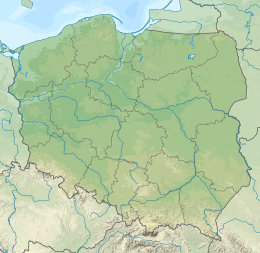Gross-Rosen concentration camp
| Gross-Rosen | |
|---|---|
| Nazi concentration camp | |

Model of the Gross-Rosen main camp,
from the Rogoźnica Museum
Location of Gross-Rosen at Rogoźnica, Poland
|
|
| Operation | |
| Period | Summer of 1940 – February 14, 1945 |
| Prisoners | |
| Total | 125,000 (in estimated 100 subcamps) |
| Victims | 40,000 |
Coordinates: 50°59′57″N 16°16′40″E / 50.999281°N 16.277704°E
Gross-Rosen concentration camp (German: Konzentrationslager Groß-Rosen) was a German network of Nazi concentration camps built and operated during World War II. The main camp was located in the village of Gross-Rosen not far from the border with occupied Poland, in the modern-day Rogoźnica in Lower Silesian Voivodeship, Poland; directly on the rail-line between the towns of Jawor (Jauer) and Strzegom (Striegau).
At its peak activity in 1944, the Gross-Rosen complex had up to 100 subcamps located in eastern Germany, Czechoslovakia, and on the territory of occupied Poland. The population of all Gross-Rosen camps at that time accounted for 11% of the total number of inmates trapped in the Nazi concentration camp system.
KZ Gross-Rosen was set up in the summer of 1940 as a satellite camp of the Sachsenhausen concentration camp from Oranienburg. Initially, the slave labour was carried out in a huge stone quarry owned by the SS-Deutsche Erd- und Steinwerke GmbH (SS German Earth and Stone Works). In the fall of 1940 the utilization of labour in Upper Silesia was taken over by the new Organization Schmelt formed on the orders of Heinrich Himmler. It was named after its leader SS-Oberführer Albrecht Schmelt. The company was put in charge of employment from the camps with Jews intended to work for food only. The Gross-Rosen location close to occupied Poland was of considerable advantage. Prisoners were put to work in the construction of a system of subcamps for expelees from the annexed territories. Gross Rosen became an independent camp on May 1, 1941. As the complex grew, the majority of inmates were put to work in the new Nazi enterprises attached to these subcamps.
...
Wikipedia

